

Introduction to Mechanical Comparator
Catalog
What is a Mechanical Comparator?Working Principle of Mechanical ComparatorMechanical Comparator TypesMechanical Comparator vs Electrical Comparator Applications of Mechanical comparatorsIn ConclusionFrequently Ask QuestionsRelated ArticlesGenerally, comparators are used for linear measurements, and there are a variety of comparators available today. They differ in how they amplify and record the measurements. Right now, engineers tend to group comparators into two categories: high amplification and low amplification, which reflects the complexity of the technology behind these devices. Comparators are classified in different ways based on the method they use for amplifying and recording measurements, such as mechanical, mechanical-optical, electronic, electrical, pneumatic, and even multi-check or projection comparators. These different types of comparators come in many variations, giving users the flexibility to choose the most appropriate and cost-effective option for a particular metrology application. In this article, we’ll take a look at a mechanical comparator, its working principle, and its applications.
What is a Mechanical Comparator?
A mechanical comparator is a measuring instrument that uses mechanical components like gears, levers, pinions, and racks to achieve magnification. These components are mainly used to amplify the movement, improving the precision of the instrument. Below is a diagram of a mechanical comparator.
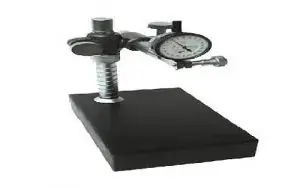
Mechanical Comparator
Working Principle of Mechanical Comparator
The working principle of a mechanical comparator is based on using mechanical means to magnify small deviations. The way the small movement of the indicator is magnified in all mechanical comparators is through a gear train and levers. These comparators can provide magnifications ranging from 300 to 1000. A mechanical comparator is also referred to as a "microcator," which is used for linear measurements through a relative contact technique.
Mechanical Comparator Types
Mechanical comparators come in several types, such as the following:
- Dial Indicators
- Read Type Comparators
- Johanson Mikro Kator
- Sigma Comparators
Dial Indicators
A dial indicator is a simple type of mechanical comparator, known for its sensitivity and versatility. It uses a gear system along with a pinion and rack. The dial indicator works on the principle of a rack and pinion system, where the spindle's linear movement is magnified by the arrangement of the rack and pinion.
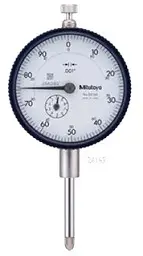
Dial Indicators
The dial indicator mechanical comparator is mainly used to determine errors in geometric shapes, like roundness, taper, ovality, and more. It helps identify errors in things like alignment, surfaces, squareness, and parallelism.
This type of comparator is used for comparing two heights or distances within very small limits. It’s also used for testing the compression and tension of materials. Additionally, it can verify the accuracy of milling machine arbors and check the arrangement of lathe machine centers when using a bar between centers.
Read-type Comparator
A reed-type mechanical comparator is used to compare the dimensions of a workpiece against typical dimensions. On the outside, it looks similar to other mechanical comparators. However, its internal construction and working principle are much simpler compared to other types of mechanical comparators.
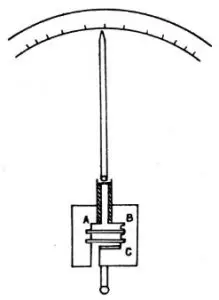
Reed Type Comparator
In this type of mechanical comparator, the plunger’s linear movement is simply defined by the read mechanism. First, this comparator is set using a known dimension. After that, the reading on the indicator is adjusted to zero. Once the part being measured is placed beneath the pointer, the comparator shows the difference in the dimension.
Johanson Mikrokator
The Johanson Mikrokator is a type of mechanical comparator that was invented by a Swedish engineer named H. Abramson. It was later introduced and manufactured by a Swedish company, C.H. Johansson Ltd. This mechanical comparator is mainly used for comparing and measuring. It's considered one of the most important mechanical comparators due to its simple design and working principle.
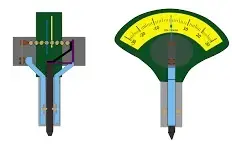
Johanson Mikro kator
The Johanson Mikrokator is the simplest mechanical comparator used to achieve mechanical magnification. It works on a button-spinning principle with a string loop. When the measuring plunger moves up or down using a bell crank lever, the strip changes its length, as the elbow functions like a bell crank lever. As the strip stretches, the glass pointer moves to show the change in the strip’s length or the plunger’s movement.
Sigma Comparator
The Sigma comparator is a type of mechanical comparator introduced by an instrument manufacturing company in the USA. These comparators are primarily used to measure the roughness of a surface by checking the dimensional difference between the standard value and the measured value of the surface material. The magnification range of this comparator is between 300 and 500. A compression spring controls the measuring pressure. The magnification achieved depends on the length of the lever on either side of the pivot.
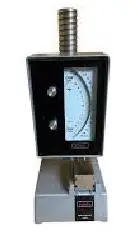
Sigma comparator
Mechanical Comparator vs Electrical Comparator
The differences between a mechanical comparator and an electrical comparator include the following:
| Mechanical Comparator | Electrical Comparator |
| A mechanical comparator is a type of measuring instrument that is made up of mechanical means to get magnification | An electrical comparator is an electro-mechanical measuring system that is made up of electrical means to get the magnification. |
| This comparator includes a number of moving parts. | This comparator includes less number of moving parts. |
| There is a high rate of wear & friction because of more moving parts available in this system. | There is a low rate of wear & friction because of fewer moving parts available in this system. |
| This comparator is not highly accurate. | This comparator is highly accurate. |
| This comparator reading does not affect variations within the power supply. | This comparator reading will affect by variations within the power supply. |
| Its maintenance is easy. | Its maintenance is not easy. |
| It is not expensive. | It is expensive. |
| This does not depend on the external current supply. | This comparator needs an external current supply. |
| This comparator is very sensitive to vibrations. | This comparator is not sensitive to vibrations due to less number of movable parts |
| The range of Magnification is fairly low compared to the electrical type. | The range of Magnification is higher. |
Advantages
The advantages of mechanical comparators include the following:
- They are not expensive compared to other types of amplifying devices.
- These comparators don’t require an external electricity supply.
- They provide extremely high magnification.
- The optical lever is lightweight.
- They are easy to understand due to the linear scale.
- They are compact, sturdy, and very easy to operate.
- They are suitable for normal workshop conditions and are portable.
Disadvantages
The disadvantages of mechanical comparators include the following:
- They have more moving parts, so eventually, the accuracy can decrease, and friction becomes higher.
- The accuracy will drop if there's any negligence with the moving parts.
- These comparators have more inertia, making them sensitive to vibrations.
- The measuring range is limited once the pointer moves past a fixed scale.
- They have high parallax errors because the pointer moves along a fixed scale.
- It's very difficult to set up adjustments to modify the magnification.
Applications of Mechanical comparators
Mechanical comparators have a few key uses:
- The reed-type mechanical comparator is mainly used to measure the dimensional deviation of a workpiece against a standard dimension.
- These comparators are used in mass production and laboratory testing for analysis.
- They're commonly found in manufacturing companies, like those making outer rings, bearing inner parts, bearing cages, races, and automobile cylindrical components.
- The mechanical comparator mechanism is used in devices like micators (small spring measuring heads), minicators (spring-lever indicators), and opticators (spring-optical measuring heads).
- A mechanical optical comparator combines mechanical and optical parts to enhance the movement of the plunger.
- These comparators are also great for measuring surface roughness by checking the dimensional variation between the standard and measured values of a surface.
In Conclusion
To sum up, a mechanical comparator is a type of linear measurement device designed to compare large numbers of identical dimensions. They don’t give exact dimensions but show the variation from a set dimension during measurement. They're not used as complete measuring devices, but they compare two dimensions at a time. Typically, comparators include magnifying devices to make even small variations from the standard size more noticeable.
By the way, can you tell me, what exactly is a comparator?
Frequently Ask Questions
What is a mechanical comparator used for?
A mechanical comparator is a tool that uses parts like gears, levers, pinions, and racks to magnify things, which helps improve measurement accuracy.
What are the uses of comparators?
A comparator circuit compares two voltages and gives an output of either a 1 (for the voltage on the positive side) or a 0 (for the voltage on the negative side) to show which one is bigger. Comparators are commonly used, for example, to check if an input has reached a certain set value.
What are the disadvantages of mechanical comparators?
Disadvantages of Mechanical Comparators:
- More moving parts mean more friction.
- Inertia is higher: These instruments often have more inertia, so they’re very sensitive to vibrations.
- Accuracy is lower: Because of more friction and higher inertia, these tools tend to be less accurate.
What is the function of a comparator?
The job of a comparator is to compare two analog input signals and give a digital or logic-level output based on that comparison. In this video, we’ll go over how an analog comparator works and some important specs, like input offset voltage (VOS).
What is the advantage of using comparators over comparable?
The Comparable interface is used for one way of sorting, while the Comparator interface allows for different ways to sort things.
Related Articles
Introduction to Optical Comparators
Subscribe to JMBom Electronics !













